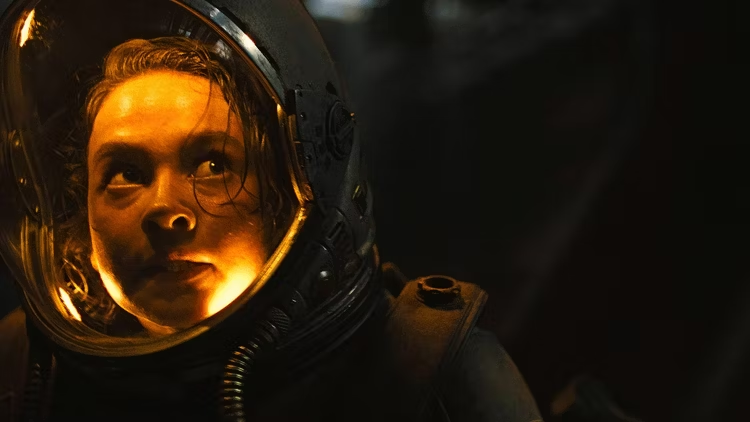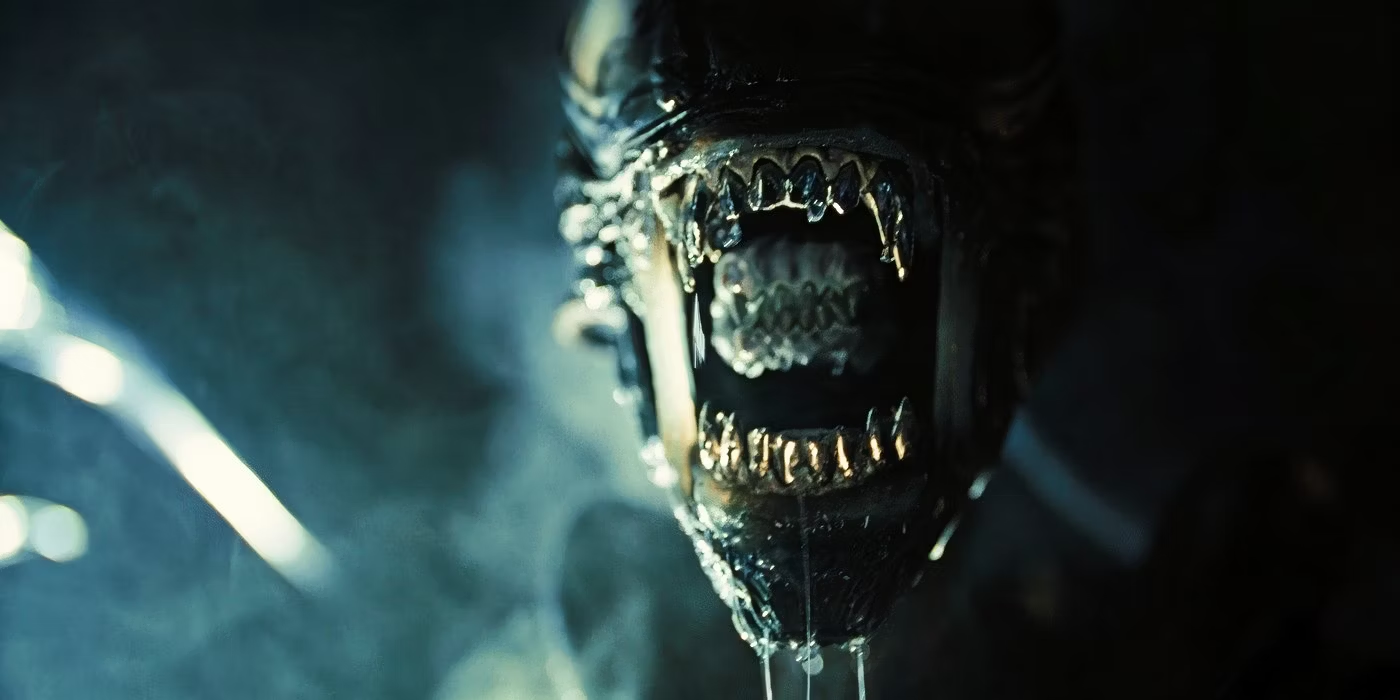The year is 2024 and we get the first Alien-verse movie since 1997 (disregarding AVPs), directed by someone other than Ridley Scott. The latter however had been one of the people mentoring director, screenwriter Fede Alvarez, and also otherwise producing the new sci-fi tale, which shows Gen Z in intense sequences fighting the nasty hissing old Xenomorphs.
Another name linking “Romulus” to the original “Alien” is Walter Hill, one of the producers of all the previous “Alien” franchise installments.
 Archie Renaux as Tyler and Cailee Spaeny as Rain in "Alien: Romulus". Source
Archie Renaux as Tyler and Cailee Spaeny as Rain in "Alien: Romulus". Source
The way I see it, part of the whole “Alien” message had always been critique of the more savage aspects of capitalism. Right from the start it had people of working class having to make a choice between losing their wages or carry out an unexpected burdensome, potentially dangerous or even fatal task in interests of the company Weyland-Yutani they’d be employed by. Fede Alvarez’s “Romulus” (co-written by a long time collaborator Rodo Sayagues) goes right back to those origins to begin its story, and expands the known Alien-verse of that timeline beyond automated ore and oil refineries tugged by Nostromo star freighter as we find ourselves on a planet without a Sun-like starlight, where one of the Weyland-Yutani mining colonies is situated. The proletariat and its realities there are easy to connect to certain aspects of colonial history of Americas from the age of empires, particularly New Spain and Peru with mita and the impacts of working environment on miners’ health. The latter comes into focus, providing a consistent perspective later on in the movie with the help of Rook – a synthetic similar to Ash in the original “Alien”.
All of the above is already telling about the intention to tie in the “Romulus” with established and well known concepts in the franchise, and the fact is – Fede Alvarez’s movie really is a fan fiction more than anything. There are bits and bobs from every movie in the “Alien” franchise scattered across it. Even details such as aesthetics of the computer design in it impress right from the beginning, being reconciled with ones in the original movie to a fine, agreeable degree. This may seem like an aspect not worth mentioning at first, but when I think about the number of movie sequels that get slated, and often failing to live up to the creative effort offered by the original work... Pointing out the sequel is actually agreeable seems to be of particular significance, especially in the case of “Alien” franchise; it’s ought to be regarded as an achievement in its own right. In my mind there is no doubt Alvarez would have had that as an aspect requiring particular responsibility, already having proved visceral capability for creating projects based on horror classics with the 2013 “Evil Dead”. Production design and plot point choices in “Romulus” demonstrate a profound connection to the spirit of “Alien” film series. Moreover, as much as I don’t like admitting this, as far as design and effects go, Alvarez’s movie is pretty much that what I would have expected the shelved Neill Blomkamp’s project to have been. I was one of the fans truly stoked to see that project back when it was a real possibility, however in many ways “Romulus” manages to make up for that movie there that we never saw.
 Cailee Spaeny as Rain in "Alien: Romulus". Source
Cailee Spaeny as Rain in "Alien: Romulus". Source
In somewhat peculiar fashion “Romulus” is a movie that constantly hints at a prequel we’ve never seen – things that have happened, reminding me of approach taken in projects such as "Virus" and the original "Resident Evil" flick. This approach, while having the power of creating intrigue and prompting imagination, in my opinion further complicates the already difficult spatial perception and sense of location in “Alien: Romulus”. Indeed this has to be that installment in the franchise, which makes the coordination most difficult by comparison, not making it easy to understand how many spaceships are there, where they are at any given point, how they are structured and when we are dealing with a cargo of highly regulated equipment rather than a spaceship. Needless to say, in such environments, if editing techniques in scenes at certain locations (such as rooms dedicated to medical experimentation) are being used to ramp up the suspense and sense of alarm while disorienting the viewer with rapidly changing shots, angles and focal points, creating confusion that way, the spatial details for the viewer can get quite obscure. All that seems to have been intended as part of rhythm there, but ends up driving the metaphorical alarm pointer into overdone range. If this hadn’t been the case, the “Romulus”’ pacing would have been perfect imo, making for the filmmaker easier to sync his audience with the quite palpable intention to keep the viewer on the edge nearly all the time.
 Cailee Spaeny as Rain in "Alien: Romulus". Source
Cailee Spaeny as Rain in "Alien: Romulus". Source
“Overdone” was something I rated David’s preoccupation with art and self expression in “Covenant” with. However the designs there were altogether one of the two cornerstones that I thought saved that movie from being a failure, another of those being the structure of the screenplay, delivered with perfect pacing. Ever since “Alien Resurrection” I have come to understand the true uniqueness of H. R. Giger’s work in “Alien” contexts because the 1997 movie managed to put on display that what happens when a novel artistic style in the franchise clashes with the original one. Unfortunately, Fede Alvarez has made a decision to include a reference to that part of the franchise in “Romulus”. Fan fiction overdone, ruining an otherwise well built narrative with Rook’s reverse engineering efforts and astute rational deductions about how facehuggers use heat signatures to identify their prey. The aforementioned, in my opinion, had provided an ample pool of possibilities, but it looks like the reference to “Alien Resurrection” had ended being more important in order to provide some philosophical and artistic commentary on humankind rather than create a new mutation for the franchise purposes. That, my friends, is how films with excellent potential sometimes lose their plot, creating environment and circumstances of becoming a different movie, but obviously never become one because big budget studio productions, especially ones that are part of a well established franchise, can’t afford turning into something else. As a result the audience is left with scenes that don’t feel like part of the whole project. “Alien Resurrection” all over again, where “Prometheus” approach would have done a lot better imo. Or perhaps those scenes were an attempt to show what sort of experiments the Engineers were up to either on LV-223 or Earth? If so, it's still a creative misfire in "Romulus" imo as "Alien" had always been about potential bio-weapons - the fragility of human body (or that of an Engineer) would never fit the purpose. Even if created specifically for mining tasks. No matter the intention there, the creative outcome clashes with Xenomorph - the central antagonistic creature on every level.
 Cailee Spaeny as Rain and David Jonsson as Andy in "Alien: Romulus". Source
Cailee Spaeny as Rain and David Jonsson as Andy in "Alien: Romulus". Source
Regarding the philosophical and social commentary side of “Romulus”, there is something perplexing and paradoxical about all that. In the lead role of Rain we’ve got a new up and coming Gen Z star Cailee Spaeny, who’d been previously working in two Alex Garland’s projects: “Devs” and “Civil War”. There is always a lot of philosophical and social commentary in Garland’s work. In “Romulus” Spaeny’s character along with the rest of the ensemble team there all come across as largely unfazed by Xenormorph’s nature and carryings-on, focusing on survival. There are no questions about who might have created the creature, where would it come from, how hostile it is et al. The group Rain is part of go from one surprise to another as if encounter with such a hostile and highly accustomed to hunting organism would be part of inevitability in space, accepted without raising questions. Xenomorph in “Romulus” is not being perceived and evaluated as a living being, which would require some sort of understanding about its place in environment; that what it does and why it does what it does. All of the above does leave one with question about how intentional this aspect in “Romulus” is because considering the environment the characters are from, it might be possible the value of human life, consequently any life of any consequence, may not be something anyone with their background would get philosophical about. There is certain juxtaposition, when this is compared to the aspect of synthetics or, as David Jonsson’s Andy points out, “artificial person” in “Romulus”. We definitely are reminded why some people hate the androids, but more importantly than that we can see how those artificial beings can serve as companions and emotional support. That kind of science fiction was a future possibility back in 1979, but in 2024 it’s already here. So the screenwriters have gotten a bit philosophical about it, it can’t be regarded as anything else but social commentary already, and in the movie all that only partly comes from something artificial. The contrast between how two types of entities that aren’t human in “Romulus” are treated is peculiar.
Where “Alien: Romulus” is in my top of “Alien” movies:
- “Aliens”
- “Alien”
- “Alien Resurrection”
- “Alien: Romulus”
- “Alien 3”
- “Prometheus”
- “Alien: Covenant”
Peer Ynt

